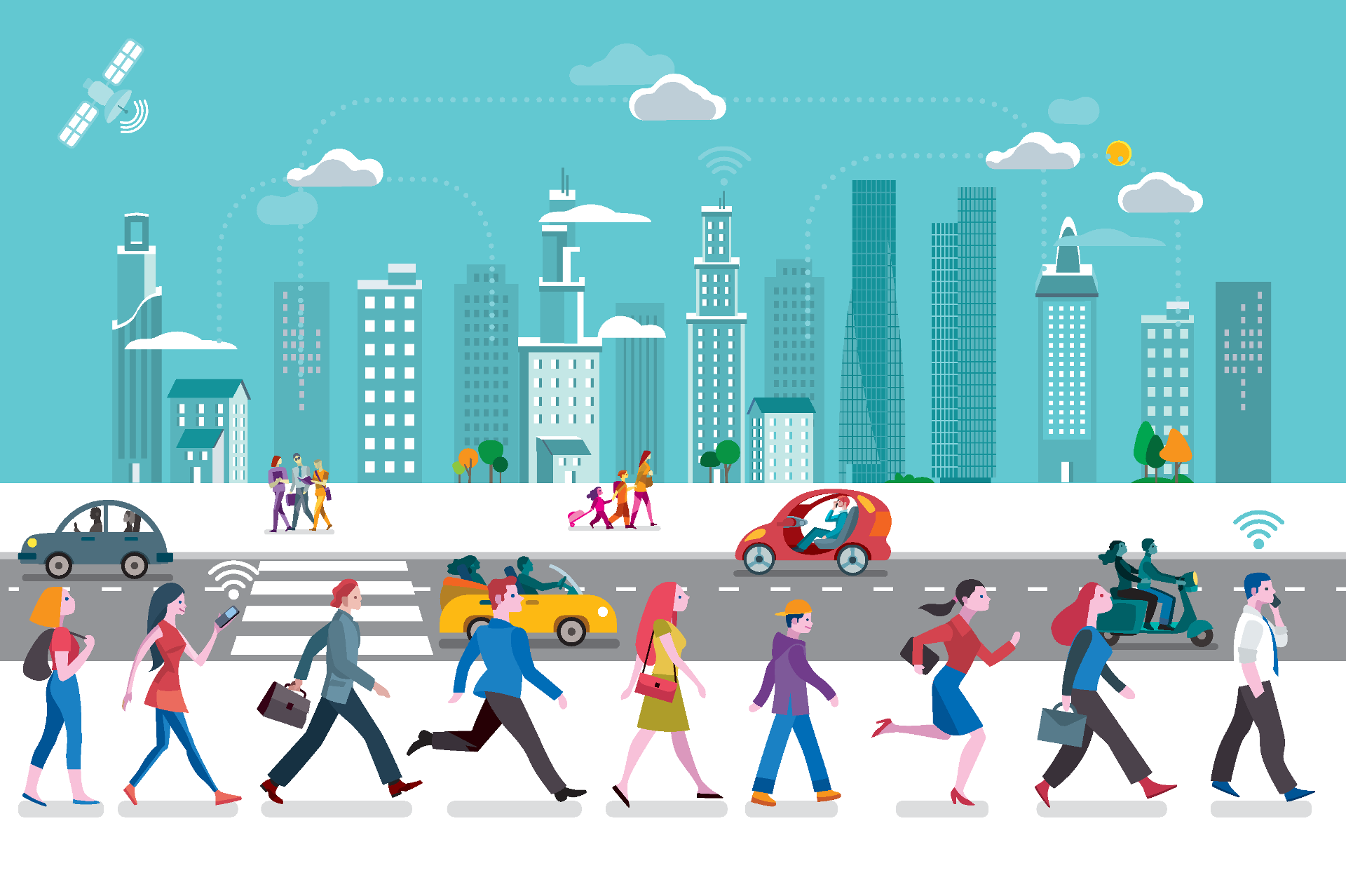Data is taking us in new directions: How digitalization is changing city mobility - Course Monster Blog

The ease and speed with which we may move around a city have a huge effect on individuals who live and work there, affecting our livelihoods, wellness, and quality of life. Mobility is critical to the efficient operation of cities.
According to Heiko Huettel, Microsoft EMEA’s automotive head, innovation enabled by a mix of digital technology and collaboration between local governments, transportation providers, and mobility firms will help offer the answers required. Mobility is evolving into a smart platform, fueled by connection, real-time data, and artificial intelligence.
Cities are growing in size and in importance
According to the latest TomTom Traffic Index, traffic has been at all-time lows in many places around the world since the beginning of the pandemic, with one-fifth (19%) less congestion globally and congestion down by an average of 26% during rush hour (Europe: 24%; North America: 40%; Asia 11%). However, the roads will not remain calm for long. TomTom’s vice president of traffic and travel, Ralf-Peter Schäfer, believes it will recover.
“That is why now is the moment for city planners, policymakers, businesses – and drivers – to assess what they will do to make future roads less crowded,” he says.
According to UN figures, more than half (54%) of the world’s population already lives in cities, with that figure expected to climb to 70% by 2030.
Economic potential is a big draw for cities. New York City contains more wealth than the whole country of Canada. London has the same GDP as the Netherlands, and if Tokyo were a country in its own right, it would be the world’s 15th largest economy.
Cities have typically become more economically productive due to the concentration of enterprises, talent, and other resources. London, for example, has the highest productivity in the United Kingdom, more than 50% more than many of the country’s former industrial heartlands, according to the Institute for Public Policy Research.
Cities are facing mounting challenges as mobility hits the buffer
According to Open Data Institute research, some cities are no longer benefiting from scale-related productivity increases. The reason: pressure on public transportation infrastructure. In terms of economic production, Birmingham, the United Kingdom’s second-biggest city, acts as a city with a third of its population during peak travel hours. It is far from an outlier.
Not only are expanding populations putting a burden on mobility, but e-commerce has roughly tripled in the previous five years (even before adjusting for the pandemic), resulting in a spike of congestion induced by last-mile distribution.
As a result, there is increasing pressure for mayors and municipal authorities to take action to decrease traffic, reduce pollution, reduce carbon emissions, and assist in urban redevelopment to protect the health and economics of their cities.
As part of its aspirations to become carbon neutral, Copenhagen is investing in a variety of micro-mobility programs, aiming to employ this form of transportation for more than half of all journeys by 2025.
Mobility needs are evolving, are cities ready?
Regulatory and policy demands, such as the need to cut carbon emissions and improve air quality, adapt to changes in people’s wants and behaviors, increase in e-commerce delivery, a rise in remote working, and other factors, are increasing the complexity.
During the pandemic, lockdowns served as a behavioral deterrent. “circuit breakers,” adds Huettel, forcing many individuals to rethink their mobility demands and options.
With flexible, “hybrid” employment on the rise (76% of European organizations currently have remote work rules), many office workers will likely commute less frequently or during off-peak hours. And this is intensifying pre-crisis tendencies like the transition away from private automobile ownership and fixed-schedule public transportation and toward new mobility alternatives like micro-mobility, subscription- and shared-transport services, he argues.
Huettel adds that it will take time for the effects of these changes to be realized and for us to identify between disruption induced by the pandemic and longer-term adjustments in mobility. However, one pre-crisis trend remains the demand for improved methods for moving people and things throughout cities.
Routing mobility through the cloud
Dr. Matthias Kempf, a founding partner of automotive consultancy Berylls Strategy Advisors, emphasizes the significance of acting quickly to fulfill increasing demands.
“We predict that cities and present mobility networks throughout the world will be unable to satisfy expanding demand, resulting in a travel capacity deficit of 150–200 billion person kilometers in the next 15 years,” he adds. “That’s the equivalent of 25,000 trips to the moon and back.”
He also claims that cities are designed largely for vehicles rather than people.
“Mobility must be designed with people in mind,” he argues. “Because people dislike changing ‘vessels,’ we want a quick, pleasant, and easy integrated transit system that encourages people to utilize the most efficient means of transportation.” What is very crucial in this case is the availability of high-quality mobility data that allows mobility systems to be planned and operated as needed.”

However, innovation is changing this. While cars will continue to be a major mode of transportation for the foreseeable future, they are being reimagined “as-a-service” and consumed as a bundle of kilometers or minutes by companies like Volkswagen’s daughter company Urban Mobility International (UMI), which has launched an electric vehicle car-sharing service called WeShare. The idea is to minimize the number of automobiles on city roadways while making better use of those that do remain. Customers use their smartphones to hire a car, which they then return to any location within the operational area. The company uses AI technology to analyze demand and parking behavior trends, allowing it to enhance its service and save operational expenses.
 Philip Reth
Philip Reth
“Our concept of how we use and experience transport is transforming,” says Philipp Reth, CEO of UMI, who says the current generation dubbed “Generation Share” is choosing to rent on demand and pay as you go.
“It’s cost-effective, convenient, and environmentally savvy,” Reth says. “It means car ownership is becoming less and less relevant for urban mobility – it’s increasingly more about a multi-modal mix of options that are interlinked in a meaningful and intelligent way.”
As cities invest in fast wireless connectivity and the cloud to create new digital highways, “digital vehicles” – vehicles that are as much made of software as they are of metal and rubber and able to intelligently interact with and navigate the outside world – will be key to realizing the potential of smart mobility, says Christoph Hartung, CEO of Bosch’s software subsidiary, ETAS.
He claims that “cars are soon becoming linked components in a connected mobility system.”

Bosch has announced a collaboration with Microsoft to create a software platform that would easily link automobiles to the cloud. The purpose of this partnership is to simplify and speed the development and deployment of vehicle software in compliance with automotive quality standards throughout a car’s lifespan. The new platform, which will be built on Microsoft Azure and include Bosch software components, will allow the software to be produced and distributed to control units and vehicle computers. The partnership will also focus on the creation of technologies to improve the efficiency of the software development process.
 Christoph Hartung
Christoph Hartung
“As cars get smarter, they open up a limitless number of options for innovation,” adds Hartung. “Having access to open, standardized platforms lower the ‘barrier to entry and shortens the time to market for new mobility services and operators.” This will assist customers by providing more options and will allow us to become wiser about how things travel across cities in linked vans and trucks.”
According to Hartung, the ecosystems to which cars are connected must be open and standardized, or else solutions would be fragmented and adoption will be blocked.
“People are traveling not only inside London, Berlin, or Paris, but from Paris to Berlin, and they want a seamless experience,” he adds.
Shashi Verma, Chief Technology Officer at Transport for London (TfL), spends a lot of time thinking about how to encourage healthy customer behaviors and choices through experiences.
“We want to guide people to the most efficient means of transportation, which is often public transportation or active modes like walking and cycling,” he explains. “However, finding out how the public transportation system works in a new city may be difficult, so many people just go and join the cab waiting.”
“That is something we do not want to happen.” We’re focused on making things easy for customers in London, such as open payments and making the experience of paying for transportation similar to buying coffee or anything else. People do utilize it, and we’ve seen big gains from bringing the right sort of ease to the right kind of product.”
 Shashi Verma
Shashi Verma
TfL’s goal, according to Verma, is not only to administer London’s transportation system but also to boost the city’s productivity. To keep the city running, a constant focus on balancing capacity and demand is required. TfL requires a variety of Microsoft tools and services to run its daily operations. For example, using Microsoft Teams to conduct remote inspections and engineering design assessments allows new infrastructure to be guaranteed and brought into service during lockdowns without the requirement for on-site presence. TfL also utilizes Azure, Microsoft’s secure cloud hosting environment, to host a variety of apps and data, including Power BI to help make data on recent passenger journeys and road collisions more accessible to the public.
“The most important use of technology is to ensure that capacity is being used properly and that we, as operators, are getting the most out of that available capacity,” Varma adds. “Digital signaling, for example, has increased the capacity of the Victoria line by over 40%.” It is difficult and expensive to establish a new train line, but if you can achieve the same by improving the technology within existing rail lines, it is a significant benefit to any city.”
Smarter mobility, according to Verma, comes down to “better use of data to lead people to make the correct decisions, and better use of technology to drive those choices and strengthen infrastructure.”
Many parties believe that public-private collaboration on open data and data sharing is important to the development of innovative mobility solutions.
Here at CourseMonster, we know how hard it may be to find the right time and funds for training. We provide effective training programs that enable you to select the training option that best meets the demands of your company.
For more information, please get in touch with one of our course advisers today or contact us at training@coursemonster.com




Comments ()